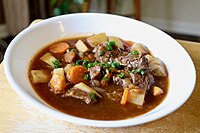
Photo from wikipedia
We used a fecal near infrared spectroscopy (FNIRS) calibration for cattle diet crude protein (CP) to evaluate the efficacy of growing degree day (GDD) as a remotely-sensed method to monitor… Click to show full abstract
We used a fecal near infrared spectroscopy (FNIRS) calibration for cattle diet crude protein (CP) to evaluate the efficacy of growing degree day (GDD) as a remotely-sensed method to monitor grazing animal nutrition. Composite fecal samples representing a herd of 24 cross bred beef cows grazing native range pastures in southwest Texas were collected along with GDD and precipitation data from April 2018 to September 2019. Regression analyses were performed to determine relationships between FNIRS-predicted diet CP and GDD within year and growing season. In 2018, FNIRS-predicted diet CP ranged from a minimum of 7.05% in August to a maximum of 9.69% in July. 2018 cumulative precipitation was 28% and 94% of the 20-year average for January-April and May-August, respectively. In 2019, FNIRS-predicted diet CP ranged from a minimum of 6.85% in September to a maximum of 12.01% in May. 2019 cumulative precipitation was 74% and 102% of the 20-year average for January-April and May-August, respectively. There were no significant (P > 0.1) simple linear relationships identified between FNIRS-predicted diet CP and GDD. There were, however, cubic exponential relationships identified in both 2018 (y = 7E-10x3 - 5E-06x2 + 0.0106x + 2.9603; R² = 0.7261; P = 0.1271) and 2019 (y = 1E-09x3 - 6E-06x2 + 0.0062x + 9.2923; R² = 0.7659; P = 0.0493). As expected, perennial range grass phenology/nutritive value (i.e. cattle diet CP) was influenced by accumulation of heat units (i.e. GDD) and precipitation. Although FNIRS is an established non-invasive method to monitor grazing animal nutrition, a remotely-sensed method to accomplish this task, such as GDD, has the potential to facilitate large-scale monitoring of grazing animal nutritional status. Our results indicate that complementary research using data from multiple locations and for more than 2 years is needed to fully evaluate these techniques.
Journal Title: Journal of Animal Science
Year Published: 2020
Link to full text (if available)
Share on Social Media: Sign Up to like & get
recommendations!